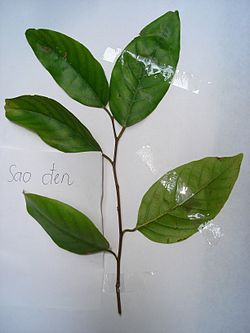| Hopea odorata | |
|---|---|
 | |
| Leaves of Hopea odorata | |
| Scientific classification | |
| Kingdom: | Plantae |
| Clade: | Tracheophytes |
| Clade: | Angiosperms |
| Clade: | Eudicots |
| Clade: | Rosids |
| Order: | Malvales |
| Family: | Dipterocarpaceae |
| Genus: | Hopea |
| Species: | H. odorata |
| Binomial name | |
| Hopea odorata | |
| Synonyms [2] | |
List
| |
Hopea odorata is a species of tree in the plant family Dipterocarpaceae. It is found in Bangladesh, Cambodia, India, Laos, Malaysia, Singapore, Myanmar, Thailand, and Vietnam. [1]






